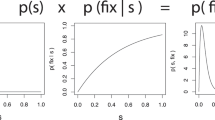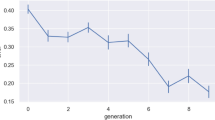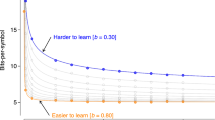Abstract
Language is our legacy. It is the main evolutionary contribution of humans, and perhaps the most interesting trait that has emerged in the past 500 million years. Understanding how darwinian evolution gives rise to human language requires the integration of formal language theory, learning theory and evolutionary dynamics. Formal language theory provides a mathematical description of language and grammar. Learning theory formalizes the task of language acquisition—it can be shown that no procedure can learn an unrestricted set of languages. Universal grammar specifies the restricted set of languages learnable by the human brain. Evolutionary dynamics can be formulated to describe the cultural evolution of language and the biological evolution of universal grammar.
This is a preview of subscription content, access via your institution
Access options
Subscribe to this journal
Receive 51 print issues and online access
$199.00 per year
only $3.90 per issue
Buy this article
- Purchase on Springer Link
- Instant access to full article PDF
Prices may be subject to local taxes which are calculated during checkout





Similar content being viewed by others
References
Pinker, S. & Bloom, A. Natural language and natural selection. Behav. Brain Sci. 13, 707–784 (1990)
Jackendoff, R. Possible stages in the evolution of the language capacity. Trends Cogn. Sci. 3, 272–279 (1999)
Bickerton, D. Language and Species (Univ. Chicago Press, Chicago, 1990)
Lightfoot, D. The Development of Language: Acquisition, Changes and Evolution (Blackwell, Oxford, 1999).
Brandon, R. & Hornstein, N. From icon to symbol: Some speculations on the evolution of natural language. Phil. Biol. 1, 169–189 (1986)
Hurford, J. R., Studdert-Kennedy, M. A. & Knight, C. (eds) Approaches to the Evolution of Language (Cambridge Univ. Press, Cambridge, UK, 1998)
Newmeyer, F. Functional explanation in linguistics and the origins of language. Lang. Commun. 11, 3–28, 97–108 (1991)
Lieberman, P. The Biology and Evolution of Language (Harvard Univ. Press, Cambridge, Massachusetts, 1984)
Maynard Smith, J. & Szathmary, E. The Major Transitions in Evolution (Freeman Spektrum, Oxford, 1995)
Hawkins, J. A. & Gell-Mann, M. The Evolution of Human Languages (Addison-Wesley, Reading, Massachusetts, 1992)
Aitchinson, J. The Seeds of Speech (Cambridge Univ. Press, Cambridge, UK, 1996)
Cavalli-Sforza, L. L. Genes, peoples and languages. Proc. Natl Acad. Sci. USA 94, 7719–7724 (1997)
Gopnik, M. & Crago, M. Familial aggregation of a developmental language disorder. Cognition 39, 1–50 (1991)
Lai, C. S. L., Fisher, S. E., Hurst, J. A., Vargha-Khadem, F. & Monaco, A. P. A forhead-domain gene is mutated in a severe speech and language disorder. Nature 413, 519–523 (2001)
Deacon, T. The Symbolic Species (Penguin, London, 1997)
Vargha-Khadem, F. et al. Neural basis of an inherited speech and language disorder. Proc. Natl Acad. Sci. USA 95, 12695–12700 (1998)
Smith, W. J. The Behaviour of Communicating (Harvard Univ. Press, Cambridge, UK, 1977)
Dunbar, R. Grooming, Gossip, and the Evolution of Language (Cambridge Univ. Press, Cambridge, UK, 1996)
Fitch, W. T. The evolution of speech: a comparative review. Trends Cogn. Sci. 4, 258–267 (2000)
Hauser, M. D. The Evolution of Communication (Harvard Univ. Press, Cambridge, Massachusetts, 1996)
Chomsky, N. A. Syntactic Structures (Mouton, New York, 1957)
Harrison, M. A. Introduction to Formal Language Theory (Addison-Wesley, Reading, Massachusetts, 1978)
Gold, E. M. Language identification in the limit. Informat. Control 10, 447–474 (1967)
Vapnik, V. N. & Chervonenkis, A. Y. On the uniform convergence of relative frequencies of events to their probabilities. Theor. Prob. Applicat. 17, 264–280 (1971)
Valiant, L. G. A theory of learnable. Commun. ACM 27, 436–445 (1984)
Vapnik, V. N. Statistical Learning Theory (Wiley, New York, 1998)
Osherson, D., Stob, M. & Weinstein, S. Systems That Learn (MIT Press, Cambridge, Massachusetts, 1986)
Pinker, S. Formal models of language learning. Cognition 7, 217–283 (1979)
Pullum, G. K. & Gazdar, G. Natural languages and context free languages. Linguist. Phil. 4, 471–504 (1982)
Shieber, S. M. Evidence against the context-freeness of natural language. Linguist. Phil. 8, 333–343 (1985)
Chomsky, N. A. Lectures on Government and Binding: The Pisa Lectures (Foris, Dordrecht, 1984)
Sadock, J. M. Autolexical Syntax: A Theory of Parallel Grammatical Representations. Studies in Contemporary Linguistics (Univ. Chicago Press, Chicago, 1991)
Bresnan, J. Lexical-Functional Syntax (Blackwells, London, 2001)
Pollard, C. J. & Sag, I. A. Head-Driven Phrase Structure Grammar (Univ. Chicago Press, Chicago, 1994)
Chomsky, N. Language and Mind (Harcourt Brace Jovanovich, New York, 1972)
Wexler, K. & Culicover, P. Formal Principles of Language Acquisition (MIT Press, Cambridge, Massachusetts, 1980)
Jackendoff, R. Foundations of Language (Oxford Univ. Press, Oxford, 2001)
Chomsky, N. in Explanation in Linguistics (eds Hornstein, N. & Lightfoot, D.) 123–146 (Longman, London, 1981)
Baker, M. C. Atoms of Language (Basic Books, New York, 2001)
Prince, A. & Smolensky, P. Optimality: From neural networks to universal grammar. Science 275, 1604–1610 (1997)
Elman, J. L. Rethinking Innateness (MIT Press, Cambridge, Massachusetts, 1996)
Tomasello, M. The Cultural Origins of Human Cognition (Harvard Univ. Press, Cambridge, Massachusetts, 1999)
Sampson, G. Educating Eve: The Language Instinct Debate (Cassell Academic, London, 1999)
Greenberg, J. H., Ferguson, C. A. & Moravcsik, E. A. (eds) Universals of Human Language (Stanford Univ. Press, Stanford, 1978)
Comrie, B. Language Universals and Linguistic Typology (Univ. Chicago Press, Chicago, 1981)
Geman, S., Bienenstock, E. & Doursat, R. Neural networks and the bias/variance dilemma. Neural Comput. 4, 1–58 (1992)
Langacker, R. Foundations of Cognitive Linguistics Vol. 1 (Stanford Univ. Press, Stanford, 1987)
Lakoff, G. Women, Fire and Dangerous Things: What Categories Reveal about the Mind (Univ. Chicago Press, Chicago, 1987)
Bates, E. & MacWhinney, B. Language Acquisition: The State of the Art (Cambridge Univ. Press, Cambridge, 1982)
Aoki, K. & Feldman, M. W. Toward a theory for the evolution of cultural communication: Coevolution of signal transmission and reception. Proc. Natl Acad. Sci. USA 84, 7164–7168 (1987)
Hurford, J. R. Biological evolution of the Saussurean sign as a component of the language acquisition device. Lingua 77, 187–222 (1989)
Cangelosi, A. & Parisi, D. Simulating the Evolution of Language (Springer, London, 2002)
Kirby, S. & Hurford, J. Proc. Fourth European Conf. on Artificial Life (eds Husbands, P. & Harvey, I.) 493–502 (MIT Press, Cambridge, Massachusetts, 1997)
Steels, L. Proc. Fifth Artificial Life Conf. (eds Langton, C. G. & Shimohara, T.) 113–131 (MIT Press, Tokyo, 1996)
Nowak, M. A. & Krakauer, D. C. The evolution of language. Proc. Natl Acad. Sci. USA 96, 8028–8033 (1999)
Nowak, M. A., Plotkin, J. B. & Jansen, V. A. A. Evolution of syntactic communication. Nature 404, 495–498 (2000)
Komarova, N. L. & Nowak, M. A. Evolutionary dynamics of the lexical matrix. Bull. Math. Biol. 63, 451–485 (2001)
Christiansen, M. H., Dale, R. A. C., Ellefson, M. R. & Conway, C. M. in Simulating the Evolution of Language (eds Cangelosi, A. & Parisi, D.) 165–187 (Springer, London, 2002)
Hashimoto, T. & Ikegami, T. Emergence of net-grammar in communicating agents. Biosystems 38, 1–14 (1996)
Hazlehurst, B. & Hutchins, E. The emergence of propositions from the coordination of talk and action in a shared worlds. Lang. Cogn. Process. 13, 373–424 (1998)
Pinker, S. The Language Instinct (Morrow, New York, 1994)
Nowak, M. A., Komarova, N. L. & Niyogi, P. Evolution of universal grammar. Science 291, 114–118 (2001)
Komarova, N. L. & Rivin, I. Mathematics of learning. Preprint math.PR/0105235 at 〈http://lanl.arXiv.org〉 (2001).
Rivin, I. Yet another zeta function and learning. Preprint cs.LG/0107033 at 〈http://lanl.arXiv.org〉 (2001).
Lightfoot, D. How to Set Parameters: Arguments from Language Change (MIT Press, Cambridge, Massachusetts, 1991)
Kroch, A. Reflexes of grammar in patterns of language change. Lang. Variat. Change 1, 199–244 (1989)
Wang, W. S. Y. in The Origins and Past of Modern Humans (eds Omoto, K. & Tobias, P. V.) 247–262 (World Scientific, Singapore, 1998)
Niyogi, P. & Berwick, R. C. Evolutionary consequences of language learning. Linguist. Phil. 20, 697–719 (1997)
Hopper, P. & Traugott, E. Grammaticalization (Cambridge Univ. Press, Cambridge, 1993)
de Graff, M. Language Creation and Language Change: Creolization, Diachrony and Development (MIT Press, Cambridge, MA, 1999)
Mufwene, S. The Ecology of Language Evolution (Cambridge Univ. Press, Cambridge, 2001)
Angluin, D. Learning regular sets from queries and counterexamples. Informat. Comput. 75, 87–106 (1987)
Angluin, D. & Kharitonov, M. When won't membership queries help? J. Comput. Syst. Sci. 50, 336–355 (1995)
Gasarch, W. & Smith, C. Learning via queries. J. Assoc. Comput. Machin. 39, 649–674 (1992)
Acknowledgements
Support from the David and Lucille Packard foundation, the Leon Levy and Shelby White initiatives fund, the Florence Gould foundation, the Ambrose Monell foundation, the National Science Foundation and J. E. Epstein is acknowledged.
Author information
Authors and Affiliations
Corresponding author
Rights and permissions
About this article
Cite this article
Nowak, M., Komarova, N. & Niyogi, P. Computational and evolutionary aspects of language. Nature 417, 611–617 (2002). https://doi.org/10.1038/nature00771
Issue Date:
DOI: https://doi.org/10.1038/nature00771
This article is cited by
-
Network analysis of terms in the natural sciences insights from Wikipedia through natural language processing and network analysis
Education and Information Technologies (2023)
-
Syntax-like Structures in Maternal Contact Calls of Chestnut-Crowned Babblers (Pomatostomus ruficeps)
International Journal of Primatology (2022)
-
The morphospace of language networks
Scientific Reports (2018)
-
The Robustness of Hybrid Equilibria in Costly Signaling Games
Dynamic Games and Applications (2016)
-
Computational methods and grammars in language evolution: a survey
Artificial Intelligence Review (2016)
Comments
By submitting a comment you agree to abide by our Terms and Community Guidelines. If you find something abusive or that does not comply with our terms or guidelines please flag it as inappropriate.



